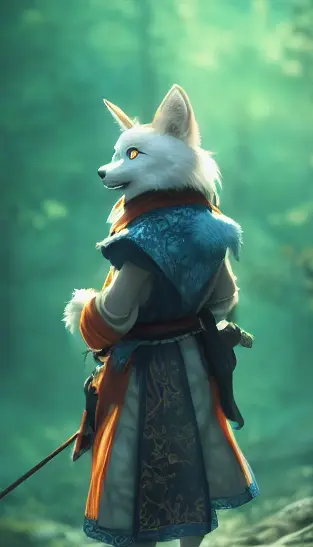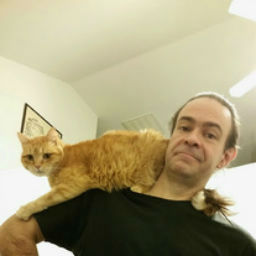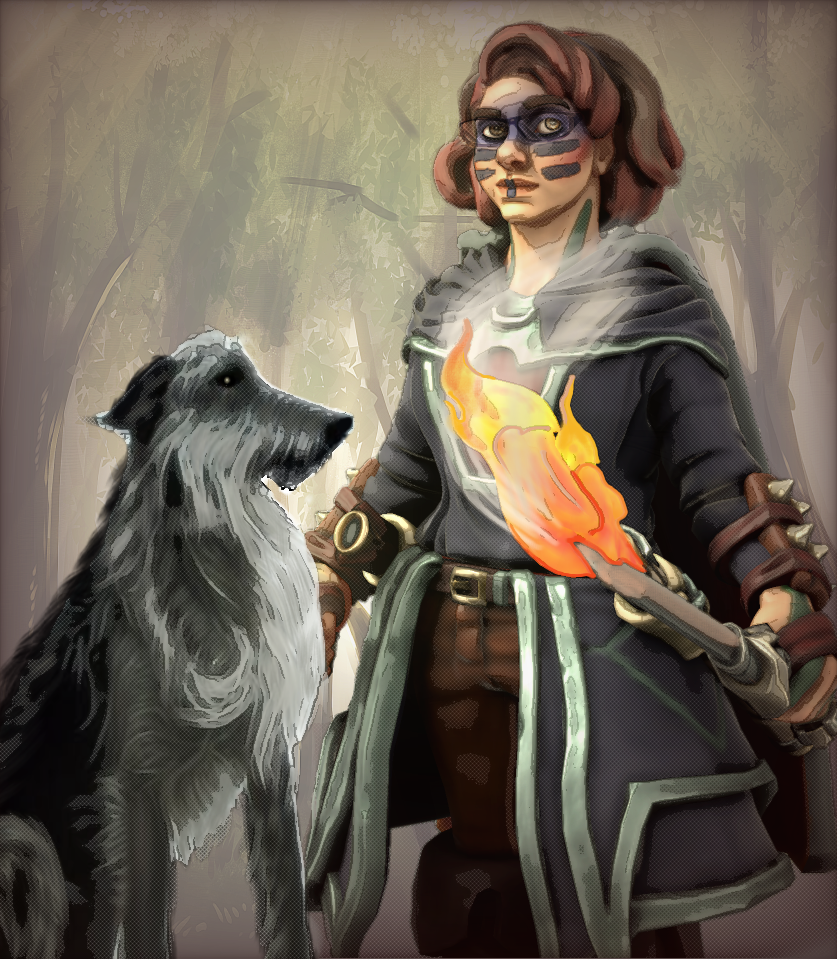Felox
Avatars of Envy
The Felox, or Fox folk, are an omnivorous, canine-like, furry humanoids who originate from the world of Vulpi Hassani. They are one of the Avatar species of the Voidrealms, considered the Avatars of Envy by the Empyreans. True to their affinity, Felox cultures are known for their master spies, politicians, and negotiators.
Basic Information
Anatomy
Feloxi are one of several furred species in the known Voidrealms. They are tall, thin, humanoids with a canine-like appearance complete with snout, fur, black nose, and bushy fox tails. Bipedal, with two humanoid arms and two digitigrade legs, the species is covered in a coat of soft fur. This fur comes in many colors, from brown, to auburn, white, or blue-gray.
The species has many distinguishing features, but the most recognizable part is their head and face. Their face has a mild triangular shape because of their narrow canine snout with black nose and pointed ears that have small tufts of fur at the tips. At the end of the snout are whiskers, often black, which turn gray with age. Their common eye color is green, though in some rare cases, it can be red or amber.
Feloxi developed short fur because of the many arid climates across Vulpi Hassani that can range from yellow-orange temperate grasslands to broad dark purple fern forests. But there are colder regions, such as the blue-snow Skycutter mountains or Figalt Tundra. In those areas, the short Felox fur becomes more dense to protect them from the icy temperatures.
No matter an individual’s fur cover, all Feloxi possess a darker hue to their fur on their hands, feet, and ears. For those Feloxi with white fur, those parts of their body might be blue-gray; if auburn fur, then black, and so on. There is one exception to fur color and that would be their tail. All Feloxi have a white tip to the end of their bushy tails.
Claws are another interesting aspect of their anatomy. A Felox’s claws are short and can retract into their fingers. They are sharp, and while Felox cultures aren’t known for intense violence like the Baboons, Feloxi can and will use these claws if necessary.
A Silent Understanding
One characteristic that is unique to this species is their tails. While other species in the Voidrealms have tails, only a Felox’s tail is prehensile. They can’t grab and lift objects with it, but Feloxi can move their tails in subtle, complex motions.
They can control the motion of their tails to such a degree that Fox cultures have incorporated this into their language. The expressive Felox language of Fosaki uses these subtle motions of their tails as emotional punctuation. But, these dextrous turns or twitches are expressive enough that Feloxi can have a full, unspoken conversation using this silent gesture-based language.
A Gift of Sight
The Feloxi have the same senses as all other species such as taste, hearing, and more. But it’s their eyesight that is special. Their homeworld is bathed in a deep, shadowy red sunlight, giving them a reddish twilight to see by during the day. As a result, the Felox have an enhanced night vision. So long as they have a small amount of light, even dim twilight, they can see clearly.
But since the sunlight of their homeworld is a perpetual deep, shadowy red, they have trouble seeing in brighter light. Light that other species would consider ‘normal’ sunlight. These would be places such as Sow Terra, Earth, or Ba’bonos to name a few. In those environments, the Feloxi use goggles or tinted lenses to protect their eyes from what they perceive as a harsh, bright light.
Biological Traits
Among the Feloxi, there are a few biological differences that come down to gender. Male Feloxi are often stronger, and taller, than the females. They also have a slightly longer snout to provide a better sense of smell. Females, while they are shorter, display a more hourglass-shaped figure, long hair on top of their head, and slightly larger ears.
The most pronounced trait that sets the genders apart is their tails. Typically, the males possess a single, fox-like tail, while women have two. A woman’s twin tails are both prehensile and can easily communicate in the silent language that all the Felox cultures use.
A Felox’s tail also holds a special place in their cultures as status symbols. Longer, more shapely tails were often thought to be a symbol of wealth and affluence. In all Felox cultures, length and dexterity of a tail can sometimes grant that Felox more influence and opportunities.
One last trait of the Felox species’ particular biology is their close affinity to magic. Feloxi are attuned to magic from birth, able to cast spells as soon as they learn to talk. But this isn’t any type of magic; Feloxi naturally can cast illusions.
This magic and spell casting is related to their tails. Other than silent communication or other gestures, a Felox can cast illusion spells with their tail or tails.
Just as their language is soft, and the species’ mannerisms are subtle, so are their illusions. They aren’t flashy but also subtle, designed to mislead or misdirect in a way to conceal a Felox’s actual goal.
Ecology and Habitats
The Felox homeworld is known for a wide range of climates from arid to temperate, complete with the occasional stretch of tundra. But this species is best suited to the purple and black fern forests that cover wide areas of Vulpi Hassani.
Not that this species cannot survive in the frigid snow or dry, arid plains. They can, as the species developed a tolerance for both abnormally hot or cold temperatures over generations. It isn’t as wide a range as tolerated by Hogs, Humans, or certain other sapient species, but it is similar.
Dietary Needs and Habits
As mentioned, Felox are omnivores who prefer lean meat as a large part of their diet, such as reptiles or birds. The blue striped Swunt Lizard is a particular favorite.
Beyond meat, they enjoy a variety of fruits and vegetables, such as Nchu redberries, Stemcactus fruit, or Uki-vine squash. Vegetables and fruits, while important, are primarily eaten during the spring and winter seasons.
Fish and moles are also part of their diet, but are less common. Foxes only eat these during the winter seasons when Vulpi Hassani reptiles are hibernating.
Civilization and Culture
Major Language Groups and Dialects
There are several Fox cultures on Vulpi Hassani, and each has their own particular dialect. But these all originate from the same spoken language, Fosaki. A soft, breathy language, Fosaki is one of the common threads that connects Fox cultures together.
But, unlike most sapient species in the Voidrealms, Fox cultures share a second common language because of their biology. The ‘silent language’ of Mkim-Fosaki. Mkim-Fosaki is like sign languages used by other sapient species like Terrans or Baboons. But, unlike those, Mkim-Fosaki is more complex. Those deft, subtle motions of a Felox’s tail can convey a wider range of topics and information in a shorter amount of time. It isn’t uncommon for many Felox to discuss business matters, throw insults, and more using just this sign language.
Some Felox cultures have even developed ‘dialects’ of Mkim-Fosaki, just as they have with Fosaki itself. But, also like Fosaki, they draw those silent dialects and slang from the same root language. So, while a member of one Felox culture may not immediately understand the meaning of a certain slang tail twitch, it isn’t difficult for them to decipher it given time.
Common Etiquette Rules
Every Felox culture has their own particular, and unique, rules of behavior. These subtle rules are what set them apart. But, there is some common etiquette that all Felox cultures share.
Despite how physical the Felox language can be with its use of Mkim-Fosaki, it’s common practice for Feloxi to not touch each other when they first meet, since it’s considered an insult. Touching another person reserved for people who already know each other.
Instead, a greeting begins with a small nod while saying ‘perch’ (pronounced ‘per-cha’), or ‘hello’. It’s considered polite to echo the word in Mkim-Fosaki at the same time. After the initial greeting, it’s considered good form for both parties to complement the other one. Often about their tails, clothing, or some other envied trait.
Another point of etiquette is to avoid using the word ‘no’ in casual conversation. Fox cultures consider saying a direct ‘no’ as impolite unless it’s an emergency. To them, that word is a harsh rejection and confrontational, if not openly rude. This runs counter to their common practice of concealing their true meaning or plans in their speech through politeness and wordplay. It’s all portion of their art of trying to be envied for their cunning or other skill in subterfuge.
The last point of etiquette would be over sharing a meal. For the Felox, a meal is a time of social communion. It’s also a prime opportunity to eliminate an envious rival. But, because open dueling is frowned on, subtler arts are used. So, it’s both common sense and good manners to use a Poison Stone to check if the food or drink has been poisoned.
Common Dress Code
Many ideas of fashion come and go, but there is a common style of dress that is often used by the Felox cultures.
Traditional Felox clothing is layered, starting with calf-length Nofor trousers designed to fit easily into soft boots. These pants are often shades of dark blue, brown, black, or dark red. As with all traditional Fox clothing, pockets are a must, with pockets at the hip and cargo pockets at the thighs. Both men and women have worn these types of pants for generations.
Next is the shirt, woven from the Telip bamboo and often dyed dark blue, purple, black or dark red. Which, on its own, might be unremarkable, but traditional Felox shirts have intricate embroidery along the neck and hemline of these shirts. Colors vary but Feloxi prefer bright colors that can shine in the dark red light of their homeworld. This embroidery, while and art form on its own, also has a practical purpose.
According to the oldest traditions, complex designs are a form of worship. Some designs are simply fashion, but a skilled artisan can weave a design to call down the blessing of the goddess Fennilk Afari, who leads the Felox pantheon. That blessing was thought to help the wearer improve themselves while sabotaging the wearer’s rival.
The layer over the shirt would often be a Soyanga vest, or the Otgul long coat. Both will have the embroidery along the hem where the buttons can close the vest or coat, but this garment is the most practical of all. They weave these garments with bone, or other plates sewn into the lining to protect against an assassin’s blade.
Beyond the traditional clothing, Feloxi enjoy bright colors in shades of red, purple, yellow, and blue. Colors that are quite vibrant under their world’s red sun and to a Feloxi's sensitive eyes.
Culture and Cultural Heritage
A common custom among the Felox cultures is the art of misdirection. It’s a skill that all Feloxi learn from a young age, and then hone over their lifetime. This includes the ability to cross a room quietly, the art of verbally dueling in a social situation, pick-pocketing, and how to fine tune their natural ability with illusion magic.
Beyond the basics, certain Felox cultures focus on specific disciplines of misdirection. For the Curisak Feloxi, they build on the art of misdirection to hone their skills as assassins. The more experienced among the Curisak Felox learn to craft and conceal unusual weapons for their grisly work. A favorite are the spring-loaded blades hidden in gloves or bracers.
Tibesan Feloxi take the art in a different direction. They build on the basics to hone skills at being able to manipulate fine mechanisms like locks. Feats of dexterity with pick-pocketing or crossing from shadow to shadow unseen in a crowded room.
Last, Tibesan Feloxi excel at the verbal arts such as how to gain someone confidence, the art of grifting, and how to debate or verbally duel in a social setting to gain information.
Common Taboos
The shared traits of Felox cultures can’t be discussed without a mention of rivalries. In these cultures, rivalries are common, as one person’s improvement fuels the envy of another. More often than not, this envy will take an ugly turn and result in assassination attempts. But they frown on open duels and similar forms of violence. In many places it’s outlawed, such as the capital city of Kit Macrotis.
As it’s taboo to show, or even suggest, actual violence against a rival, the Fox folk resort to subterfuge. Hidden poison blades, needles, and more are common choices. If visiting the home of a close ally, and a Felox has forgotten to bring a hidden dagger, it’s expected that ally would let them borrow one.
Lifespan
150 years by Earth reckoning
Average Height
5' 9" to 6'1" ( 1.8 to 1.8 m )
Average Weight
150 to 175 lbs ( 68 to 79 kg )
Geographic Distribution
Common Naming Traditions
Names are important for the Feloxi. A name identifies the person and honors their family or lineage. But it also explains something about that person. Feloxi names, though they vary slightly between cultures, also describe someone’s personality or how they think.
Felox names have three parts: personal name, lineage, and gilding. The last is preceded by either El’- or La’- depending on the culture that Felox comes from.
A Feloxi personal name, or given name, is the name assigned at birth. The same is true for the family name, which also carries the family’s reputation, good or bad. Last comes the gilding.
A ‘gilding name’ can be many things. Gilding can be a title, type of job, or even a common nickname for the person. It could also be the name of a favorite ancestor, or even a quirk in that person’s mannerisms.
Unlike the rest of their name, the gilding isn’t assigned at birth. It comes later when a young Feloxi man or woman reaches maturity. Often the gilding is a nickname based on their personality or something they are known for. At other times, it can be for the Feloxi’s profession. But it’s always unique to that person.
This suffix to a Feloxi name is always preceded by El’- or La’- depending on whether the Feloxi is from the Curisak, Tibesan, or other Feloxi cultures. Typically, El’- is used by the Curisak and La’- by the Tibesan.







And up next is the Ooo Arr Farmers language. The eternal enemies of the Felox.
LOL